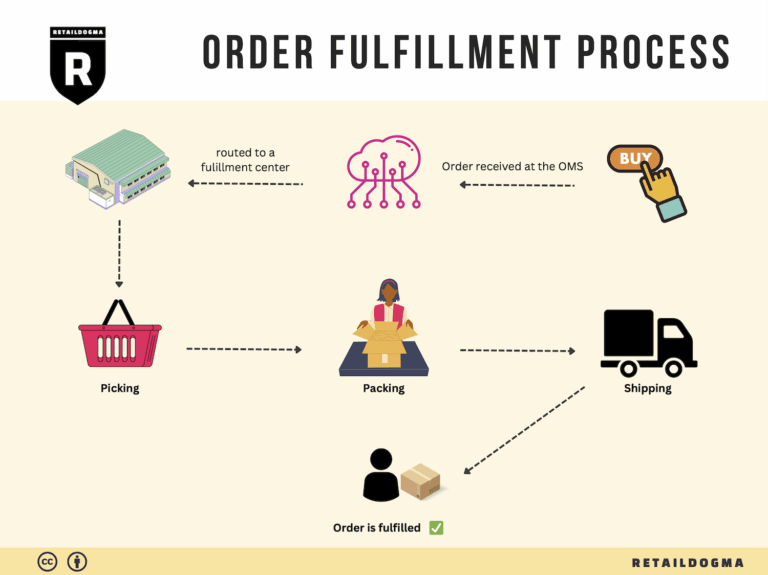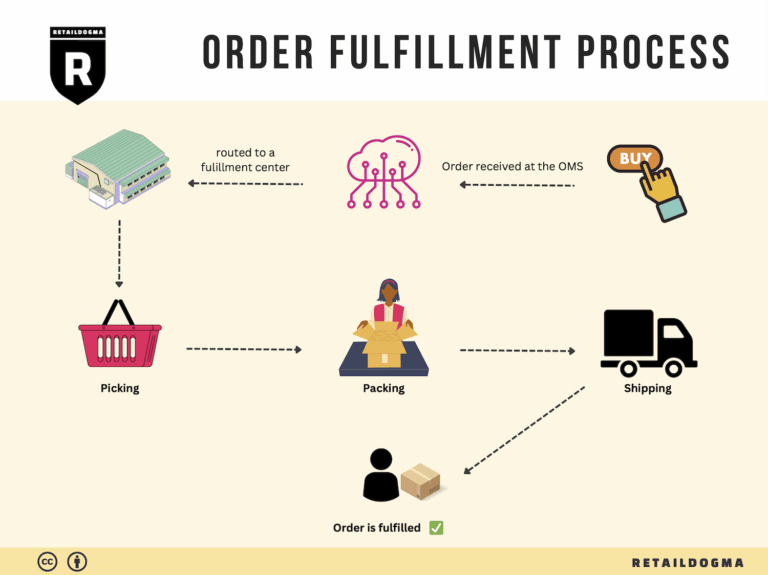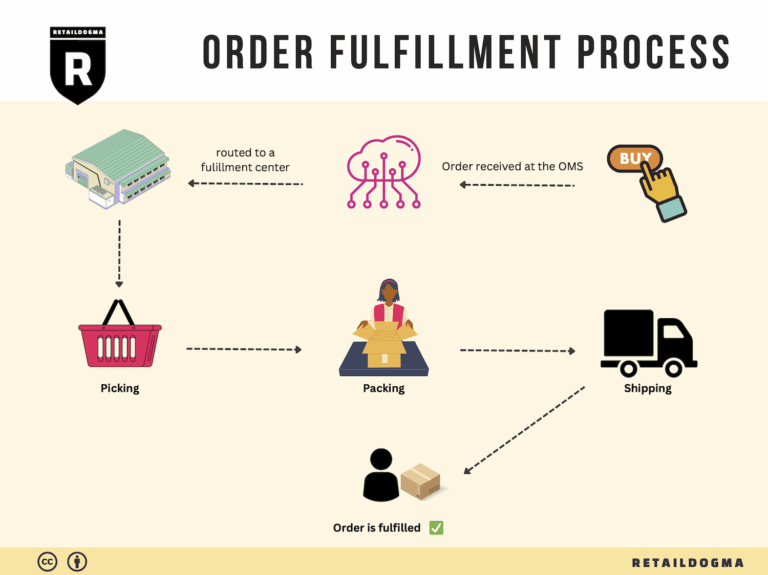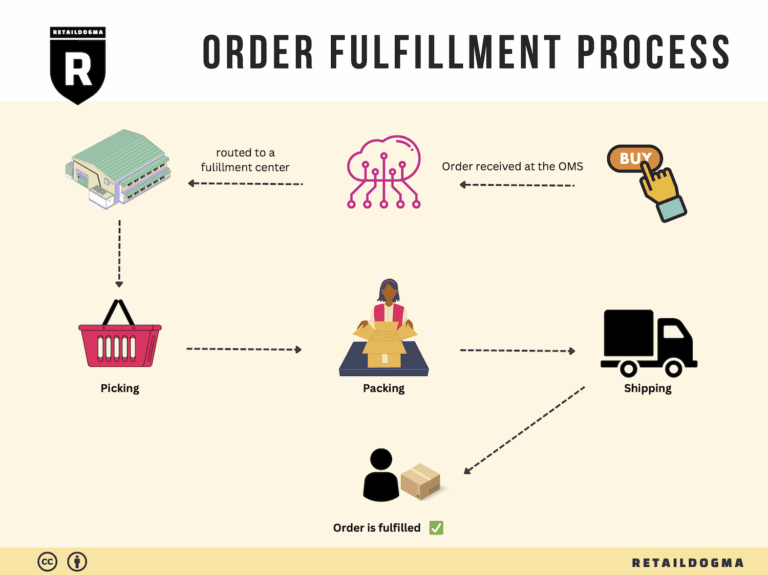What Is A Fulfillment Center? A Complete Guide (2025)
What is E-commerce Fulfillment? An Introduction for Growing Businesses
As your e-commerce business begins to grow, the excitement of increased sales can quickly turn into the stress of managing logistics. Many entrepreneurs find themselves overwhelmed with the complexities of packing and shipping orders efficiently while maintaining customer satisfaction. The process of fulfillment—the crucial step of getting a product from your warehouse to the customer’s doorstep—can become a significant pain point, especially when scaling operations.
Fulfillment encompasses everything from inventory management to order processing and shipping. It involves not only the physical movement of products but also the systems and strategies that support these activities. As your business expands, understanding the intricacies of fulfillment becomes essential. This guide aims to demystify the fulfillment process, providing you with practical insights to navigate this critical aspect of your e-commerce operations.
Exploring Fulfillment Models
In this guide, we will delve into various fulfillment models, including Third-Party Logistics (3PL) and Fulfillment by Amazon (FBA). Each model has its unique advantages and challenges, and understanding these will help you determine the best fit for your business.
Core Services of Fulfillment
We’ll also outline the core services involved in the fulfillment process, such as inventory management, order picking, packing, shipping, and returns handling. By breaking down these components, you’ll be better equipped to identify areas for improvement within your own operations.
Choosing the Right Partner
Selecting the right fulfillment partner is crucial for your business’s success. This guide will provide you with criteria to consider when evaluating potential partners, including their technology capabilities, geographical reach, and customer service standards.
Understanding Pricing
Lastly, we will discuss pricing structures commonly found in the fulfillment industry. Understanding the cost implications of different fulfillment options will empower you to make informed decisions that align with your business goals.
Empowering Smart Decisions
Ultimately, this guide aims to empower you—whether you’re an e-commerce business owner, operations manager, or entrepreneur—to make smart decisions about your logistics. By equipping you with the knowledge and tools necessary to optimize your fulfillment process, you can enhance operational efficiency, reduce costs, and elevate your customer experience. Let’s embark on this journey to transform your fulfillment challenges into a streamlined process that supports your business growth.

What You’ll Learn In This Guide
- What is E-commerce Fulfillment? An Introduction for Growing Businesses
- The Order Fulfillment Process: From ‘Buy’ Button to Customer’s Door
- Comparing Fulfillment Models: In-House vs. 3PL vs. Dropshipping
- A Deep Dive into Amazon FBA: Pros, Cons, and Who It’s For
- Core Services Offered by Fulfillment Centers
- How to Choose a Fulfillment Partner: A 6-Point Checklist
- Understanding Fulfillment Pricing: A Breakdown of Common Fees
- Frequently Asked Questions (FAQs) about Fulfillment
- Conclusion: Is Outsourcing Fulfillment the Right Move for Your Business?
- Important Disclaimer
The Order Fulfillment Process: From ‘Buy’ Button to Customer’s Door
1. Receiving Inventory
The first step in the order fulfillment process is receiving inventory. This involves the acceptance of products from suppliers or manufacturers into your warehouse. It is crucial to verify that the received goods match the purchase orders in terms of quantity and quality.
During this stage, businesses should implement a systematic approach to track incoming items. Key terms to familiarize yourself with include Stock Keeping Unit (SKU), which serves as a unique identifier for each product. Properly managing SKUs ensures that inventory levels are accurately recorded, helping to minimize discrepancies and avoid stockouts or overstock situations.
Efficient receiving practices also allow businesses to quickly update their inventory management systems, facilitating smoother operations downstream. This step sets the foundation for successful order processing and ultimately impacts customer satisfaction.
2. Warehouse Storage
Once inventory is received, the next step is warehouse storage. This involves organizing products within the warehouse to optimize space and accessibility. Efficient storage is critical as it directly influences the speed and accuracy of order fulfillment.
Utilizing a systematic storage method, such as First-In-First-Out (FIFO) or Last-In-First-Out (LIFO), can help manage inventory effectively. Moreover, categorizing items based on their sales velocity (fast, medium, slow) allows for better space allocation. Fast-moving products should be stored in easily accessible locations to minimize travel time for warehouse staff.
Effective warehouse storage not only enhances operational efficiency but also reduces labor costs by decreasing the time taken to locate and retrieve products. This is particularly important for scaling businesses aiming to increase order volumes without sacrificing service quality.
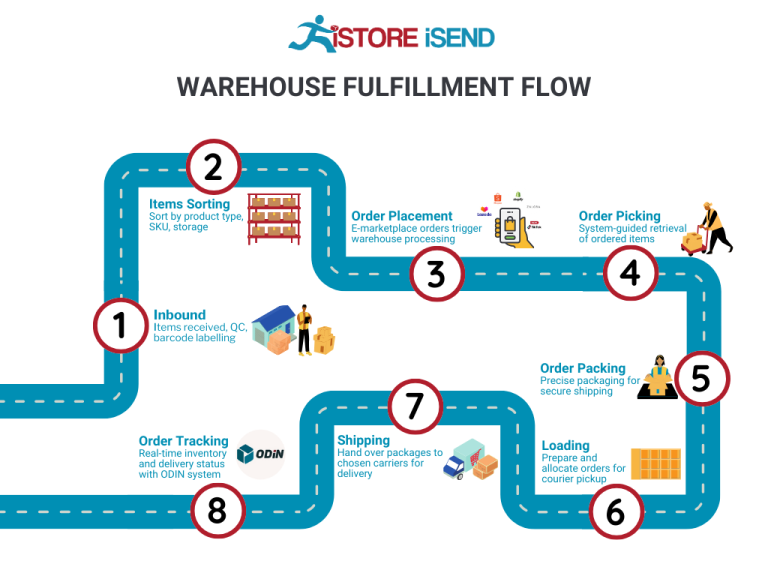
3. Order Picking
Order picking is the process where items are selected from storage to fulfill customer orders. This step is pivotal as it directly affects order accuracy and fulfillment speed. Businesses can implement various picking methods, including batch picking, wave picking, or zone picking, depending on their operational needs and order volume.
Using pick lists, which detail the items and quantities needed for each order, can streamline the picking process. Optimizing picking routes—minimizing the distance workers must travel—can enhance efficiency, allowing for more orders to be processed in less time.
An effective order picking strategy is essential for meeting customer expectations, especially in e-commerce, where speed and accuracy are paramount. Mistakes in this stage can lead to incorrect shipments, resulting in returns and potential damage to customer relationships.
4. Order Packing
Once the items are picked, the next step is order packing. This process involves carefully packaging products to ensure they arrive at the customer’s door in pristine condition. It’s vital to choose the right packaging materials that balance protection and cost-effectiveness.
Utilizing packing slips is a best practice in this stage, as they provide essential details about the order and help verify that all items are included before sealing the package. Packaging also plays a significant role in branding; businesses can use custom packaging to enhance the unboxing experience and foster brand loyalty.
Effective packing reduces the likelihood of damage during transit and helps optimize shipping costs by minimizing package weight and dimensions. Additionally, an organized packing process can significantly decrease fulfillment time, contributing to a better overall customer experience.
5. Shipping & Delivery
The final step in the fulfillment process is shipping and delivery. This involves selecting the appropriate shipping method and carrier, as well as ensuring that packages are dispatched on time. It’s essential to offer various shipping options to cater to different customer needs, balancing speed and cost.
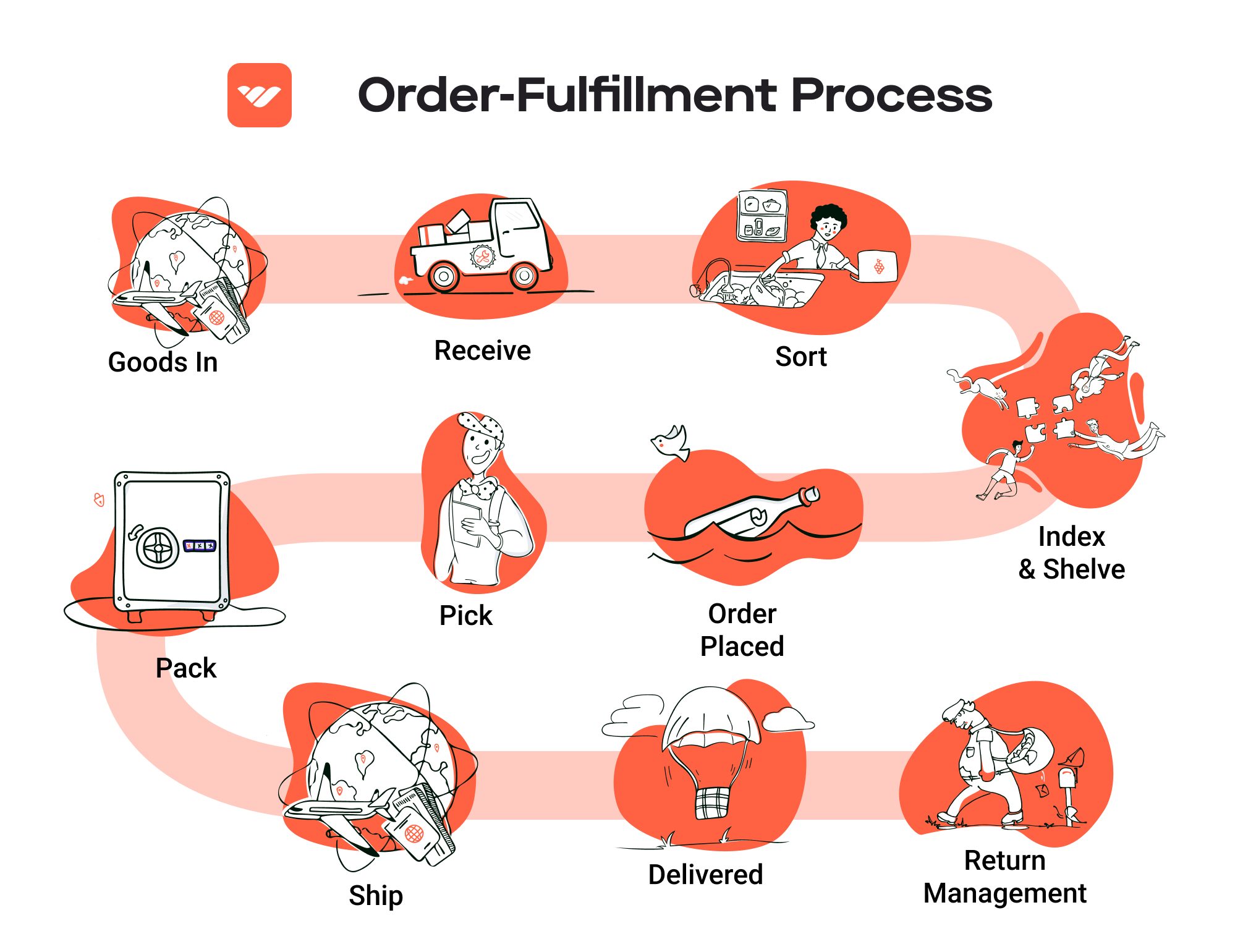
Utilizing shipping software can streamline this process by automating label generation and tracking updates. Key terms associated with this step include “last-mile delivery,” which refers to the final leg of the shipping journey from a distribution center to the end customer. Efficient last-mile logistics can significantly impact delivery speed and customer satisfaction.
Effective shipping and delivery practices not only fulfill customer orders but also enhance the overall buying experience. Ensuring timely and accurate deliveries is crucial for maintaining a positive reputation in the competitive e-commerce landscape, where customer expectations continue to rise.
By meticulously managing each step of the order fulfillment process, e-commerce businesses can scale their operations while delivering exceptional service to their customers.
Comparing Fulfillment Models: In-House vs. 3PL vs. Dropshipping
Fulfillment Model Comparison
| Model | Who Handles Inventory | Best For (Business Stage) | Key Advantage | Key Disadvantage |
|---|---|---|---|---|
| In-House Fulfillment | The business itself | Startups and small businesses | Complete control over operations | High overhead costs and resource constraints |
| Third-Party Logistics (3PL) | An external logistics provider | Growing and scaling businesses | Scalability and access to expert resources | Less control over inventory and fulfillment speed |
| Dropshipping | Suppliers or manufacturers | New businesses or niche markets | Low initial investment and risk | Lower profit margins and reliance on suppliers |
In-House Fulfillment
In-house fulfillment involves managing the entire logistics process within your own organization. This model is typically adopted by startups and small businesses that want to maintain complete control over their inventory and shipping processes. By handling fulfillment internally, businesses can ensure that they meet their quality standards, customize packaging, and build a direct relationship with customers. This can be particularly advantageous when building brand loyalty or when the product requires special handling.
However, in-house fulfillment comes with significant challenges. It requires a robust investment in warehousing, staff, technology, and systems for inventory management. The overhead costs can be substantial, especially as sales volume increases. Additionally, businesses must be prepared to manage the complexities of logistics, which can divert attention from core activities like marketing and product development. As demand fluctuates, the business may struggle with resource constraints, leading to inefficiencies and customer dissatisfaction if not managed effectively.
Third-Party Logistics (3PL)
Third-party logistics (3PL) providers take over the logistics and fulfillment processes for e-commerce businesses. This model is ideal for growing and scaling businesses that need to optimize their operations without the burden of managing logistics internally. By partnering with a 3PL, companies can tap into a network of warehouses, shipping services, and expert logistics management, allowing them to focus on their core competencies.
The key advantage of using a 3PL is scalability; as your business grows, your logistics capabilities can grow with it without the need for significant capital investment. Additionally, 3PLs often have established relationships with carriers, which can lead to better shipping rates and faster delivery times. However, businesses may face challenges such as reduced control over inventory management and fulfillment speed. If a 3PL’s processes are not well-aligned with the business’s needs, it could lead to delays, inaccuracies, and ultimately, customer dissatisfaction. It’s crucial to choose a reliable 3PL that understands your business model and can adapt to your specific requirements.
Dropshipping
Dropshipping is a fulfillment model where the retailer does not keep products in stock but instead transfers customer orders and shipment details to a manufacturer or wholesaler, who then ships the products directly to the customer. This model is particularly appealing to new businesses or those targeting niche markets, as it requires minimal upfront investment. Entrepreneurs can test product ideas and market demand without the financial risk associated with holding inventory.
The primary advantage of dropshipping is the low barrier to entry, allowing businesses to start with little capital. It also eliminates the need for warehousing and inventory management, freeing up resources for marketing and customer acquisition. However, dropshipping comes with significant drawbacks, including lower profit margins due to reliance on suppliers for fulfillment. Additionally, businesses have limited control over product quality, shipping times, and inventory availability, which can lead to customer dissatisfaction and challenges in building a strong brand reputation. Success in dropshipping often hinges on finding reliable suppliers and maintaining strong communication to mitigate these risks.
Conclusion
Choosing the right fulfillment model is crucial for the success of an e-commerce business. In-house fulfillment offers complete control but comes with high overhead costs. Third-party logistics provide scalability and expertise, though they may reduce direct oversight. Dropshipping allows for low-risk entry into the market but can lead to lower profit margins and quality concerns. Each model has its unique strengths and weaknesses, and the choice ultimately depends on the specific needs, goals, and resources of the business. By carefully evaluating these factors, e-commerce entrepreneurs can select the fulfillment strategy that aligns best with their operational goals and customer expectations.
A Deep Dive into Amazon FBA: Pros, Cons, and Who It’s For
Understanding Fulfillment by Amazon (FBA)
Fulfillment by Amazon (FBA) is a service that allows e-commerce sellers to leverage Amazon’s extensive logistics network to store, pick, pack, and ship their products directly to customers. By using FBA, sellers can take advantage of Amazon’s robust infrastructure, including their fulfillment centers, customer service, and returns handling. This service not only simplifies the logistics for sellers but also enhances the overall customer experience by providing fast and reliable shipping options.
How FBA Works
-
Set Up Your Account: Sellers start by creating an Amazon Seller account and enrolling in the FBA program. This involves listing products and selecting which items they want to fulfill through Amazon.
-
Send Your Inventory to Amazon: Once enrolled, sellers prepare their products according to Amazon’s packaging and labeling requirements. They then ship their inventory to Amazon’s fulfillment centers, where the products will be stored until sold.
-
Order Processing: When a customer places an order for a product fulfilled by FBA, Amazon handles the entire process. This includes picking the item from the warehouse, packing it, and shipping it directly to the customer.
-
Customer Service and Returns: FBA also manages customer service inquiries and handles returns on behalf of the seller, allowing sellers to focus on growing their business rather than logistics.
Pros of FBA
1. Prime Eligibility
One of the most significant advantages of FBA is that it qualifies products for Amazon Prime, which is a major selling point. Prime members are more likely to purchase products that offer free two-day shipping, significantly boosting sales potential.
2. Customer Trust
Using FBA enhances customer trust in the seller’s products. Amazon is known for its reliable shipping and excellent customer service. When sellers utilize FBA, they benefit from Amazon’s reputation, which can lead to increased conversion rates.
3. Multi-Channel Fulfillment
FBA offers the flexibility of multi-channel fulfillment, allowing sellers to use Amazon’s logistics for orders placed on other platforms, such as their own website or eBay. This can streamline operations and reduce the complexity of managing multiple fulfillment channels.
4. Simplified Logistics
FBA takes the burden of logistics off the seller’s shoulders. With Amazon handling inventory storage, order processing, and customer service, sellers can focus on marketing and growing their business rather than worrying about the complexities of shipping and fulfillment.
5. Scalable Operations
As businesses grow, FBA allows for easy scaling. Sellers can increase their inventory without needing to invest in additional warehouse space or staff, as Amazon’s infrastructure can handle increased order volumes seamlessly.
Cons of FBA
1. High Fees
FBA comes with various fees, including storage fees and fulfillment fees, which can significantly cut into profit margins. Sellers must carefully calculate these costs to ensure that their pricing strategy remains competitive while still profitable.
2. Strict Inventory Rules
Amazon has strict guidelines regarding inventory management. Sellers must adhere to these rules, which include limits on storage space and requirements for product condition. Failure to comply can lead to penalties or removal from the program.
3. Commingling Risks
FBA products from different sellers may be commingled in Amazon’s warehouses, meaning that a seller’s inventory could be shipped to customers alongside products from other sellers. This raises concerns about product quality and authenticity, as sellers have less control over their inventory.
4. Loss of Control
While FBA simplifies logistics, it also means that sellers relinquish some control over the fulfillment process. They depend on Amazon for the quality of service, which can lead to inconsistencies in order handling and shipping times.
5. Complex Returns Management
While Amazon handles returns, this can complicate inventory management for sellers. Returned items may not always be in sellable condition, and the seller must account for these items in their inventory and financial planning.
Who is FBA Best For?
Fulfillment by Amazon is ideal for e-commerce businesses that want to scale quickly without the overhead of managing logistics themselves. It is particularly beneficial for:
- Small to Medium-Sized Sellers: Those who lack the resources to manage their own fulfillment centers or logistics operations will find FBA a cost-effective solution.
- Brands Looking to Increase Visibility: Sellers who want to tap into Amazon’s vast customer base and enhance their product visibility through Prime eligibility.
- Businesses with High Order Volumes: Companies that anticipate high sales volumes and need a scalable solution to manage increased order processing.
- Multi-Channel Sellers: Brands that sell on multiple platforms and want a seamless fulfillment process across all channels.
However, businesses that are highly price-sensitive or that sell unique, lower-volume products may want to carefully consider the associated costs and risks before fully committing to FBA.
In conclusion, while Fulfillment by Amazon offers substantial benefits, it is crucial for sellers to weigh these against the potential drawbacks to determine if it aligns with their business goals and operational capabilities.
Core Services Offered by Fulfillment Centers
Inventory Management & Warehousing
Inventory management and warehousing are foundational services offered by fulfillment centers, crucial for e-commerce businesses seeking to streamline operations and enhance customer satisfaction. This service involves the systematic tracking and organization of stock levels, ensuring that products are readily available when customers place orders.
Effective inventory management allows businesses to maintain optimal stock levels, reducing the risks of overstocking or stockouts. Fulfillment centers often utilize advanced inventory management software that provides real-time data on stock levels, sales trends, and reordering needs. This technology enables business owners to make informed decisions about inventory purchases, ensuring they have enough products to meet demand without incurring unnecessary carrying costs.
The benefits of robust inventory management include improved cash flow, as businesses can allocate resources more efficiently, and enhanced customer satisfaction through timely order fulfillment. By partnering with a fulfillment center that specializes in inventory management, e-commerce businesses can focus on growth strategies, knowing their warehousing and stock levels are being expertly managed.
Pick and Pack Services
Pick and pack services are integral to the fulfillment process, involving the selection of items from inventory and packing them for shipment. This service is designed to optimize the order fulfillment process, ensuring that orders are accurately filled and dispatched quickly.
The pick and pack process begins when an order is received. Fulfillment center staff locate the ordered items in the warehouse, pick them, and then pack them securely for shipment. This process is often enhanced by technology, such as barcode scanners and automated sorting systems, which reduce human error and speed up operations.
For e-commerce businesses, the benefits of efficient pick and pack services are significant. Quick and accurate order fulfillment leads to higher customer satisfaction and repeat business. Additionally, streamlined pick and pack operations can reduce labor costs and improve operational efficiency, allowing businesses to scale more effectively as order volumes increase.
Kitting and Assembly
Kitting and assembly services involve the grouping of individual items into ready-to-sell sets or kits, which can include assembling products before they are shipped. This service is particularly beneficial for businesses that sell products requiring assembly or those that offer bundled items to enhance customer value.
Fulfillment centers can handle the entire kitting process, from sourcing components to assembling them into final products. This not only saves e-commerce businesses time and labor costs but also ensures that products are assembled correctly and packaged professionally.
The primary benefit of kitting and assembly services is the ability to offer customers unique product offerings that can differentiate a business in a competitive market. Additionally, by outsourcing these tasks to fulfillment centers, businesses can focus on core activities such as marketing and customer engagement while ensuring that their products are ready for sale without the logistical challenges of in-house assembly.
Returns Management (Reverse Logistics)
Returns management, or reverse logistics, is a critical service offered by fulfillment centers that deals with the process of handling returned goods. This includes receiving, inspecting, restocking, or disposing of returned items based on predetermined criteria. An effective returns management process can significantly impact customer satisfaction and loyalty.
When customers receive defective or unsatisfactory products, an efficient returns process can make all the difference. Fulfillment centers often provide streamlined return solutions, including pre-paid return labels, easy return instructions, and prompt processing of refunds or exchanges. This not only enhances the customer experience but also minimizes the operational burden on e-commerce businesses.
The benefits of effective returns management are twofold. First, it fosters customer trust, as shoppers appreciate hassle-free return policies and processes. Second, it allows businesses to recapture value from returned items, either by restocking them for resale or by recycling materials. By leveraging the expertise of fulfillment centers in managing returns, e-commerce businesses can turn a potentially negative experience into a positive one, ultimately driving customer loyalty and repeat purchases.
Conclusion
In conclusion, the core services offered by fulfillment centers—inventory management and warehousing, pick and pack services, kitting and assembly, and returns management—are essential for e-commerce businesses aiming to scale efficiently and enhance customer satisfaction. By partnering with a fulfillment center, business owners can leverage specialized expertise and technology to streamline operations, reduce costs, and focus on growth strategies. As the e-commerce landscape continues to evolve, utilizing these services will be vital for maintaining a competitive edge.
How to Choose a Fulfillment Partner: A 6-Point Checklist
Location & Warehouse Network
Importance:
The geographical location of your fulfillment partner’s warehouses can significantly impact shipping times and costs. A partner with strategically located facilities can help you reach your customers faster and reduce transportation expenses.
Questions to Ask:
– Where are your warehouses located, and how do they align with my target markets?
– How do you manage inventory across multiple locations?
– Can you provide insights into your shipping times and costs based on these locations?
Technology & Integrations
Importance:
In today’s digital landscape, seamless technology integration is crucial for efficient operations. Your fulfillment partner should offer robust technology solutions that can integrate with your e-commerce platform, inventory management systems, and other tools you use.
Questions to Ask:
– What technology solutions do you offer for order management and tracking?
– How easily can your systems integrate with my existing software?
– Do you provide real-time inventory visibility and reporting capabilities?
Specializations (e.g., Cold Storage, Oversized Items)
Importance:
Different products require different handling and storage methods. Choosing a partner that specializes in your specific product needs—such as cold storage for perishables or handling oversized items—ensures that your products are stored and shipped under optimal conditions.
Questions to Ask:
– What specific product categories do you specialize in?
– Do you have the necessary facilities and equipment for my product type?
– Can you provide case studies or examples of how you’ve handled similar products in the past?
Scalability & Capacity
Importance:
As your business grows, your fulfillment needs will evolve. It’s essential to partner with a fulfillment provider that can scale alongside your business, whether that means increasing capacity during peak seasons or accommodating new product lines.
Questions to Ask:
– What is your current capacity, and how do you manage fluctuations in demand?
– Can you accommodate seasonal spikes in volume, and if so, how?
– Do you have a track record of scaling operations effectively for other clients?
Pricing and Contracts
Importance:
Understanding the pricing structure and contract terms is vital for maintaining profitability. You need a clear picture of all costs involved, including storage fees, shipping rates, and any potential hidden charges.
Questions to Ask:
– Can you provide a detailed breakdown of your pricing structure?
– Are there any additional fees I should be aware of, such as for returns or special handling?
– What are the terms of the contract, and is there flexibility for renegotiation as my business evolves?
Customer Support & Reviews
Importance:
Exceptional customer support can make a significant difference in your fulfillment experience. A responsive partner can help resolve issues quickly and ensure a smooth operation. Additionally, customer reviews and testimonials can provide insights into a partner’s reliability and service quality.
Questions to Ask:
– What support channels do you offer (phone, email, chat), and what are your response times?
– Can you share testimonials or case studies from current or past clients?
– How do you handle issues or disputes that may arise during the fulfillment process?
Conclusion
Choosing the right fulfillment partner is a critical decision that can impact your e-commerce business’s efficiency and customer satisfaction. By carefully evaluating potential partners based on the six key points outlined in this checklist, you can ensure that you make an informed choice that aligns with your business goals and growth plans. Always remember to conduct thorough due diligence, including site visits if possible, to gain a comprehensive understanding of each potential partner’s capabilities and culture.
Understanding Fulfillment Pricing: A Breakdown of Common Fees
Initial Setup Fees
When partnering with a fulfillment provider like FedEx, initial setup fees can be one of the first costs that businesses encounter. These fees typically cover the administrative and logistical tasks required to onboard your business into the fulfillment system. This may include account setup, integration with your e-commerce platform, and initial inventory entry.
Calculating initial setup fees can vary significantly between providers. Some may charge a flat fee, while others may base their charges on the complexity of the integration or the volume of products you plan to store. It’s essential to ask for a detailed breakdown of what these fees entail to avoid unexpected costs down the line.
Receiving Fees
Receiving fees are charged when your inventory arrives at the fulfillment center. This fee covers the labor involved in unloading, inspecting, and entering your products into the warehouse management system.
Typically, receiving fees are calculated per pallet or per item. For instance, if you send a truckload of goods, you might pay a single fee for the entire shipment or a per-pallet fee depending on how the fulfillment center structures its pricing. It’s crucial to understand how the receiving process works, as discrepancies in shipment quantities can lead to additional charges or delays in inventory availability.
Storage Fees (per pallet/bin)
Storage fees are ongoing costs incurred for keeping your inventory in the fulfillment center. These fees can be charged on a per-pallet or per-bin basis, depending on how your products are stored.
Most fulfillment centers will charge storage fees monthly and may have tiered pricing based on the amount of space your inventory occupies. For example, storing a full pallet might cost more than storing a partial pallet or individual bins. Understanding these fees is vital as they can significantly impact your overall fulfillment costs, especially if you have slow-moving inventory that occupies space for extended periods.
Pick & Pack Fees (per item/order)
Pick and pack fees are some of the most critical costs in the fulfillment pricing model, as they directly relate to order processing. These fees cover the labor involved in picking items from storage, packing them for shipment, and preparing them for delivery.
The calculation for pick and pack fees can vary widely. Some providers charge a flat fee per order, while others might charge based on the number of items within each order. For instance, if you have an order consisting of five different items, you may incur a higher fee than an order with just one item. It’s beneficial to inquire about any potential discounts for bulk orders or regular shipping patterns, as this could lead to cost savings.
Shipping Fees
Shipping fees are often the most variable component of fulfillment pricing. These fees depend on the destination, package dimensions, weight, and chosen shipping speed. FedEx, for instance, offers a range of shipping options that can affect costs, from standard ground shipping to expedited services.
Shipping fees can be calculated using a combination of factors, including dimensional weight pricing, which takes into account the volume of the package, not just its actual weight. It’s also important to consider additional costs such as residential delivery surcharges or fuel surcharges that may apply.
Tips for Getting an Accurate Quote
-
Be Specific with Your Needs: When requesting quotes, provide detailed information about your product dimensions, expected order volume, and the types of services you require. This helps fulfillment centers offer tailored quotes.
-
Ask for a Breakdown of Fees: Ensure that the quote includes a detailed breakdown of all potential fees—setup, receiving, storage, pick and pack, and shipping. This transparency will help you understand the true cost of fulfillment.
-
Inquire About Volume Discounts: Many fulfillment centers offer discounts based on order volume or long-term contracts. If you anticipate growth, ask about potential savings.
-
Evaluate Additional Services: Consider any extra services you may need, such as returns processing or kitting. Understanding the costs associated with these services will provide a more comprehensive view of your total fulfillment expenses.
-
Compare Multiple Providers: Don’t settle for the first quote you receive. Compare costs and services from multiple fulfillment centers to ensure you’re getting the best value for your business.
By understanding these common fees and how they’re calculated, e-commerce business owners can make more informed decisions about their fulfillment options, ultimately leading to a more efficient and cost-effective operation.
Frequently Asked Questions (FAQs) about Fulfillment
1. What is a FedEx Fulfillment Center?
A FedEx Fulfillment Center is a logistics facility that handles the storage, picking, packing, and shipping of products for e-commerce businesses. By utilizing FedEx’s extensive network and technology, businesses can streamline their order fulfillment process, ensuring faster delivery times and improved inventory management.
2. What’s the difference between a warehouse and a fulfillment center?
While both warehouses and fulfillment centers store products, their functions differ significantly. A warehouse primarily focuses on the storage of goods, often for long-term inventory. In contrast, a fulfillment center is geared towards processing customer orders quickly and efficiently, including picking, packing, and shipping items directly to consumers.
3. What is a 3PL (Third-Party Logistics)?
A 3PL, or Third-Party Logistics provider, is a company that offers outsourced logistics services, which can include warehousing, fulfillment, and shipping. FedEx can function as a 3PL by managing the entire supply chain for e-commerce businesses, allowing them to focus on growth and sales rather than logistics.
4. How much do fulfillment services cost?
Costs for fulfillment services can vary widely based on factors such as order volume, storage needs, and specific services required (like packaging and returns handling). Generally, businesses can expect to pay for storage space per cubic foot, picking and packing fees per order, and shipping costs based on weight and destination. It’s advisable to contact FedEx for tailored pricing based on your specific needs.
5. How does FedEx Fulfillment help in inventory management?
FedEx Fulfillment provides comprehensive inventory management solutions that allow businesses to track stock levels in real-time, automate reordering processes, and conduct regular inventory audits. This helps minimize stockouts and overstock situations, ultimately leading to better cash flow and customer satisfaction.
6. Can I integrate FedEx Fulfillment with my e-commerce platform?
Yes, FedEx Fulfillment offers integration options with various e-commerce platforms, including Shopify, WooCommerce, and Magento. This integration enables seamless order processing, inventory updates, and shipment tracking, enhancing the overall efficiency of your e-commerce operations.
7. What are the benefits of using FedEx Fulfillment?
Using FedEx Fulfillment can provide several advantages, including:
– Faster shipping times: Leverage FedEx’s extensive shipping network for quicker deliveries.
– Scalability: Easily adjust your fulfillment capabilities as your business grows.
– Expertise: Benefit from FedEx’s logistics experience and technology.
– Cost savings: Optimize shipping and handling costs through efficient operations.
8. How does FedEx handle returns for e-commerce businesses?
FedEx Fulfillment offers streamlined returns management services, allowing customers to initiate returns easily. The process can include prepaid return labels, automated tracking, and efficient restocking procedures, which help maintain customer satisfaction and reduce the impact of returns on your bottom line.
9. What types of products can be fulfilled through FedEx?
FedEx Fulfillment can handle a wide variety of products, from consumer goods and electronics to apparel and health products. However, certain restrictions may apply to hazardous materials or perishable items. It’s advisable to check FedEx’s guidelines for specific product categories.
10. How can I get started with FedEx Fulfillment?
To begin utilizing FedEx Fulfillment services, you can visit the FedEx Fulfillment website and sign up for an account. From there, you can assess your needs, explore pricing options, and integrate their services with your e-commerce platform. Additionally, FedEx provides resources and support to guide you through the onboarding process.
Conclusion: Is Outsourcing Fulfillment the Right Move for Your Business?
Evaluating the Benefits of Outsourcing Fulfillment
Outsourcing your fulfillment process can be a transformative decision for your e-commerce business. By leveraging a dedicated fulfillment service, such as FedEx, you can save invaluable time that can be redirected towards scaling your operations and enhancing customer engagement. This time-saving aspect is particularly crucial for entrepreneurs and operations managers who often juggle multiple responsibilities.
Additionally, utilizing a fulfillment service provides inherent scalability. As your business grows, so too do your logistics needs. A robust fulfillment partner can seamlessly adapt to fluctuations in order volume, allowing you to scale operations without the headache of managing additional resources or infrastructure. This flexibility is vital in today’s fast-paced e-commerce environment, where consumer demand can shift dramatically.
Moreover, fulfillment services bring specialized expertise to the table. With professionals who are well-versed in inventory management, order processing, and shipping logistics, you can ensure that your products are delivered efficiently and accurately. This expertise not only enhances your operational efficiency but also improves customer satisfaction—an essential component for repeat business and brand loyalty.
However, it’s important to recognize that not all fulfillment partners are created equal. Choosing the right partner is critical to your business’s growth trajectory. Take the time to assess potential partners based on their technology, service offerings, and customer support.
As a strategic next step, consider conducting an audit of your current shipping and fulfillment processes. Identify pain points and evaluate whether a fulfillment partner could help streamline operations, reduce costs, and enhance customer experience. This proactive approach could unlock new opportunities for your business and position you for sustained growth in the competitive e-commerce landscape.
Important Disclaimer
⚠️ Important Disclaimer
The information in this guide is for educational purposes. Fulfillment services, pricing, and platform features change frequently. Always conduct your own due diligence and consult with providers directly before making business decisions.


